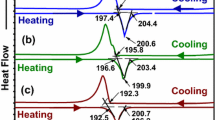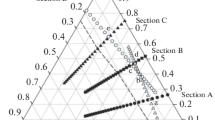Abstract
The melting points of commonly used commercial brazing filler metals (Ti–15Cu–15Ni and Ti–15Cu–25Ni) are higher than the β-phase transformation temperature of the SP700 titanium alloy, and therefore, the microstructure of the brazed joint and the joint shear strength will deteriorate. To design the proper Ti–Cu–Ni–Zr solder, the phase equilibrium relationship in the Ti–rich corner of this Ti–Cu–Ni–Zr system was studied by CALPHAD (CALculation of PHAse Diagrams) method, and a set of critical thermodynamic descriptions of the phases of Ti–Cu–Ni–Zr was obtained. The relationship between the composition and the melting point of the solder was clarified by the liquidus projection based on the description. The influence of Cu, Ni, and Zr on the phase and structure of brazing solders was analyzed. The SP700 titanium alloy was brazed using Ti–60Zr–10Cu–14Ni amorphous solder designed in this work. After brazing at 890 °C for 1 h, the needle-like structure was formed and the brazed joint was composed of 47 mol% NiTiZr, 5 mol% BCC, 35 mol% Cu(Ti, Zr)2, and 13 mol% NiZr2 phases, which successfully avoid forming harmful (Cu, Ni)(Ti, Zr) phases. The brazing solder exhibits a high shear strength of 575.9 MPa which is higher than traditional solders.
Graphical abstract










Similar content being viewed by others
References
Lin GY, Xiao MQ, Feng D, Liu XY, Wang HY, Zhang R (2020) Microstructural and mechanical properties of ZA10 alloy tubes and their weld seams prepared by Conform continuous extrusion. Rare Met 39:707–715
Wang L, Fan Q, Zhu X, Wang D, Chen K, Gong H, Qian Y, Peng Y et al (2021) Effect of tungsten micro-scale dispersed particles on the microstructure and mechanical properties of Ti–6Al–4V alloy. J Alloys Compd 851:156847
Li Q, Lin X, Luo Q, Chen Y a, Wang J, Jiang B, Pan F (2022), Kinetics of the hydrogen absorption and desorption processes of hydrogen storage alloys: A review, Int. J. Miner. Metall. Mater., 29: 32-48.
Li Q, Peng X, Pan F (2021) Magnesium-based materials for energy conversion and storage. J Magnes Alloy 9:2223–2224
Ya B, Zhou B, Yang H, Huang B, Jia F, Zhang X (2015) Microstructure and mechanical properties of in situ casting TiC/Ti6Al4V composites through adding multi-walled carbon nanotubes. J Alloys Compd 637:456–460
Li X, He J, Ji Y, Zhang T, Zhang Y (2019) Study of the microstructure and fracture toughness of TC17 titanium alloy linear frictionwelding joint. Metals 9:430
Guedes A, Pinto AMP, Vieira MF, Viana F (2003) Joining Ti-47 Al-2Cr-2Nb with a Ti/(Cu, Ni)/Ti clad-laminated braze alloy. J Mater Sci 38:2409–2414. 10.1023/A:1023948917115
Liaw DW, Wu ZY, Shiue RK, Chang CS (2007) Infrared vacuum brazing of Ti-6Al-4V and Nb using the Ti-15Cu-15Ni foil. Mater Sci Eng, A 454–455:104–113
Ganjeh E, Sarkhosh H, Bajgholi ME, Khorsand H, Ghaffari M (2012) Increasing Ti-6Al-4V brazed joint strength equal to the base metal by Ti and Zr amorphous filler alloys. Mater Charact 71:31–40
Ganjeh E, Sarkhosh H, Khorsand H, Sabet H, Dehkordi EH, Ghaffari M (2012) Evaluate of braze joint strength and microstructure characterize of titanium-CP with Ag-based filler alloy. Mater Des 39:33–41
Chang CT, Wu ZY, Shiue RK, Chang CS (2007) Infrared brazing Ti-6Al-4V and SP-700 alloys using the Ti-20Zr-20Cu-20Ni braze alloy. Mater Lett 61:842–845
Wang SH, Lee HH, Chen CY, Yang JR, Kao CH (2009) The variation of beta phase morphology after creep and negative creep for duplex titanium alloys. J Mater Sci 44:408–413. 10.1007/s10853-008-3131-y
Pang S, Sun L, Xiong H, Chen C, Liu Y, Li H, Zhang T (2016) A multicomponent TiZr-based amorphous brazing filler metal for high-strength joining of titanium alloy. Scripta Mater 117:55–59
Bazhenov VE, Koltygin AV, Sung MC, Park SH, Titov AY, Bautin VA, Matveev SV, Belov MV et al (2020) Design of Mg–Zn–Si–Ca casting magnesium alloy with high thermal conductivity. J Magnes Alloy 8:184–191
Wang P, Kontsevoi OY, Olson GB (2019) Thermodynamic analysis of the Co–W system. J Mater Sci 54:10261–10269. 10.1007/s10853-019-03616-3
Dargahi Noubary K, Kellner M, Hötzer J, Seiz M, Seifert HJ, Nestler B (2021) Data workflow to incorporate thermodynamic energies from Calphad databases into grand-potential-based phase-field models. J Mater Sci 56:11932–11952. 10.1007/s10853-021-06033-7
Luo Q, Guo Y, Liu B, Feng Y, Zhang J, Li Q, Chou K (2020) Thermodynamics and kinetics of phase transformation in rare earth–magnesium alloys: a critical review. J Mater Sci Technol 44:171–190
Tang Y, Li Y, Zhao W, Roslyakova I, Zhang L (2020) Thermodynamic descriptions of quaternary Mg–Al–Zn–Bi system supported by experiments and their application in descriptions of solidification behavior in Bi-additional AZ casting alloys. J Magnes Alloy 8:1238–1252
Huang X, Miao J, Li S, Taylor CD, Luo AA (2021) Co-free CuFeMnNi high-entropy alloy with tunable tensile properties by thermomechanical processing. J Mater Sci 56:7670–7680. 10.1007/s10853-020-05686-0
Li Q, Lu Y, Luo Q, Yang X, Yang Y, Tan J, Dong Z, Dang J et al (2021) Thermodynamics and kinetics of hydriding and dehydriding reactions in Mg-based hydrogen storage materials. J Magnes Alloy 9:1922–1941
Luo Q, Li J, Li B, Liu B, Shao H, Li Q (2019) Kinetics in Mg-based hydrogen storage materials: enhancement and mechanism. J Magnes Alloy 7:58–71
Xie TC, Shi H, Wang HB, Luo Q, Li Q, Chou KC (2022) Thermodynamic prediction of thermal diffusivity and thermal conductivity in Mg–Zn–La/Ce system. J Mater Sci Technol 97:147–155
SGTE unary database, Version 5.0-Scientific Group Thermodata Europe, Grenoble (2009).
Arroyave R, Eagar TW, Kaufman L (2003) Thermodynamic assessment of the Cu–Ti–Zr system. J Alloys Compd 351:158–170
Zhang H, He Y, Yang F, Liu H, Jin Z (2013) Thermodynamic assessment of Cu–Ni–Ti ternary system assisted with key measurements. Thermochim Acta 574:121–132
Davis JP, Majzoub EH, Simmons JM, Kelton KF (2000) Ternary phase diagram studies in Ti–Zr–Ni alloys. Mater Sci Eng, A 294:104–107
Tokunaga T, Matsumoto S, Ohtani H, Hasebe M (2007) Thermodynamic calculation of phase equilibria in the Nb-Ni-Ti-Zr quaternary system. Mater Trans 48:89–96
Lee GW, Gangopadhyay AK, Kelton KF (2011) Phase diagram studies of Ti–Zr–Ni alloys containing less than 40 at.% Ni and estimated critical cooling rate for icosahedral quasicrystal formation from the liquid. Acta Mater 59:4964–4973
Liu M, Wang Z, Wu J, Li Q (2015) Ti/Al2O3 interfacial diffusion: kinetic equation for growth of reaction layer and formation mechanism. J Alloys Compd 652:260–265
Luo JG, Acoff VL (2004) Using cold roll bonding and annealing to process Ti/Al multi-layered composites from elemental foils. Mater Sci Eng, A 379:164–172
Xu L, Cui YY, Hao YL, Yang R (2006) Growth of intermetallic layer in multi-laminated Ti/Al diffusion couples. Mater Sci Eng, A 435–436:638–647
Chang CT, Du YC, Shiue RK, Chang CS (2006) Infrared brazing of high-strength titanium alloys by Ti-15Cu-15Ni and Ti-15Cu-25Ni filler foils. Mater Sci Eng, A 420:155–164
Yue X, He P, Feng JC, Zhang JH, Zhu FQ (2008) Microstructure and interfacial reactions of vacuum brazing titanium alloy to stainless steel using an AgCuTi filler metal. Mater Charact 59:1721–1727
Acknowledgements
This work was financially supported by the National Natural Science Foundation of China (51734002), Science and Technology Committee of Shanghai (19010500400 and 19DZ2252900), and AVIC Manufacturing Technology Institute (201911025002).
Author information
Authors and Affiliations
Corresponding authors
Ethics declarations
Conflict of interest
The authors declared that they have no potential conflicts of interest.
Additional information
Handling Editor: P. Nash.
Publisher's Note
Springer Nature remains neutral with regard to jurisdictional claims in published maps and institutional affiliations.
Supplementary Information
Below is the link to the electronic supplementary material.
Rights and permissions
About this article
Cite this article
Zhang, Q., Chen, H., Luo, Q. et al. The design of Ti–Cu–Ni–Zr titanium alloy solder: thermodynamic calculation and experimental validation. J Mater Sci 57, 6819–6831 (2022). https://doi.org/10.1007/s10853-022-07063-5
Received:
Accepted:
Published:
Issue Date:
DOI: https://doi.org/10.1007/s10853-022-07063-5




